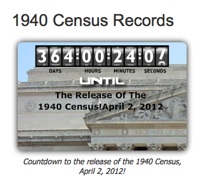Training Film for 1940 Enumerators
November 7th, 2011 Posted in On the Internet | Comments OffI have my calendar marked for April 2, 2012. Do you?
I plan to be ready by that day to search the 1940 census online for free at the National Archives website, www.archives.gov. Since the U.S. Federal Census cannot be seen by the public until it is released 72 years after the 1940 enumeration date, no one will be able to begin indexing the entries until April 2, 2012. Visit the 1940 Census Records page of the National Archives site for ideas about how to do some sleuthing in advance to narrow down a search to only the pages covering your ancestor’s (or your) neighborhood. While there, you will also find just about everything you ever wanted to know and everything you will ever need to know about the 1940 census.
Constance Potter, of the National Archives gave a detailed introduction to the 1940 census at the Federation of Genealogical Societies National Conference in September 2011, and it was very interesting to hear the about what questions were asked back in 1940. Kathy Huber, the Tulsa City-County Library’s genealogy librarian introduced it last July in Tulsa as well (download her handout from the TCCL Genealogy website).
While in each of the censuses 1880-1930, the census taker asked for not only the place of birth of each person on the census, he (or she) also asked for the place of birth of the parents. That information won’t appear on the 1940 census except for one person out of every 20. The U. S. Census Bureau was more interested in 1940 to study the workforce, so the census taker asked questions about what kind of work, how many weeks unemployed, etc. One question that intrigues me is where each person was living on 1 April 1935. The answer could be “Same House,” “Same Place” (if the same town but a different house), or the town, county, and state or country where the person lived.
To get an idea of the nature of the instructions to the enumerators, or just to get a glimpse back to 72 years ago, watch the training film now on YouTube or at the National Archives website. The mock interview of a housewife by a census taker will help to put the census taker’s job perspective, and you can hear about some of the more tricky census questions in anticipation of your look at the census when it is released.
Thanks to Dick Eastman for blogging about this today.

